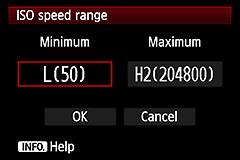In railway photography, you could be dealing with subjects that are travelling at a high speed of several hundreds of kilometres per hour. The world of railway photos offers a wide range of objects for expression, from the beautiful contour of the vehicle body, which is the crystallization of human wisdom, to the wide expanse of landscapes where the trains traverse, and scenes of people working there. A full-frame camera comes in particularly useful in situations where you want to express pair elements in photography, such as light and shadow and stillness and motion. (Reported by: Yuya Yamasaki)

EOS-1D X/ EF16-35mm f/2.8L II USM/ FL: 23mm/ Manual exposure (1/1000 sec., f/6.3)/ ISO 50/ WB: Daylight
Full-frame cameras allow you to make use of the focal length of the lens without the need for conversion. Ideally, it should be paired with a wide-angle lens to bring out the sleek shape of the train. Together, you will be able to produce images with wide tonal range even when there is strong contrast in the brightness.

EOS 6D/ EF17-40mm f/4L USM/ FL: 31mm/ Manual exposure (1/500 sec., f/4)/ ISO 800/ WB: Daylight
The mountain path was masked by clouds that brought rain to the surrounding region. To prevent the train from turning out blurry, I raised the ISO speed to gain a faster shutter speed. Not only was the tone delicate and smooth in the resulting image, the full-frame camera also demonstrated its precise resolving power with a realistic depiction.

EOS-1D X/ EF70-200mm f/2.8L IS II USM/ FL: 85mm/ Manual exposure (1/25 sec., f/2.8)/ ISO 3200/ WB: Daylight
In shots using ultra-high ISO, the contrast tends to become stronger. However, the gradation of the images produced by the full-frame camera remains smooth. The camera excels in reproducing the details and colours of shadowed and demonstrates its strengths particularly in night photography.

EOS 6D/ EF70-200mm f/4L IS USM/ FL: 200mm/ Manual exposure (1/125 sec., f/18)/ ISO 200/ WB: Daylight
The shadow and light reflection from the train forms an impressive contrast. Thanks to the wide dynamic range of the full-frame camera, a rich gradation of shadows and highlights has been produced. Also, the excellent resolving power of the camera makes it possible to bring out the texture of the train.
Realistic Railway Photography in Harsh Shooting Conditions
On top of capturing the shape of the train, you can also capture the surrounding landscapes or the speed of the train. There are many ways that you can express these. Image quality is most important to me when choosing a camera. Whether I am looking to capture the beauty of the four season, or the make of a vehicle, it will not be possible to product the image that I want if the camera is lacking in resolving power or accurate colour reproduction capabilities. I also like photography in conditions that most people avoid, such as scenes with backlight and during the night time. In both shooting conditions, the richness of graduation during high ISO spede shooting is crucial in order to maintain image quality.
Lens-wise, perhaps due to a many photographer's perception that train cars must be captured from distance, many would think that telephoto lenses are most commonly employed. However, in order to bring out the expanse or create a stronger impact, I always make use of a wide-angle lens. For me, the lens that I use is the EF16-35mm f/2.8L II USM, which offers a resolving power that matches the image quality of full-frame cameras. This lens provide, an angle of view that is easy to use as well. With a bright maximum aperture of f/2.8, this lens makes a handy companion for freezing the motion of moving trains at a fast shutter speed.
The image quality of a full-frame camera is excellent. Rather than limiting myself to simple, two-dimensional photos, I aim to leverage this high image quality to include elements such as wind and sound together with the subject, thereby evoking a realistic sensation in the viewers as if they were present at the location of the shoot.

The Canon EOS-1D X is a must-have for my works. Excellent continuous shooting performance is definitely welcome when you are photographing trains travelling at a high speed. Not only so, its high ISO speed performance allows images to be captured clearly even when there is insufficient light. Coupled with the flawless hold, operability, and functionality, the EOS-1D X is, in a way, a perfect camera.

The "EF16-35mm f/2.8L II USM" is the lens I use most. Maintaining an aperture value of f/2.8 throughout the entire zoom range, this L lens is capable of drawing out the resolving power of high-resolution full-frame cameras. It is an essential item for landscape shots that feature trains.

One of my favourites is the versatile "EF70-200mm f/2.8L IS II USM," which I use for capturing shapes, landscapes, images with strong impact. In addition to the high image quality, the IS feature offers reassuring support for handheld photography. With minimal flare and ghosting, this lens produces clear, well-contrasted photos even when you are shooting in a backlit condition.

The camera function that I frequently use is "ISO expansion." When taking pan shots in a bright environment, for example, I would lower the ISO speed to "L" to slow down the shutter speed almost without having to stop down the aperture. Meanwhile, to freeze the motion of a moving train at night, I would select "H" to capture the shot at a fast shutter speed as much as possible.

Yuya Yamasaki
Born in 1970 in Hiroshima, Yamasaki is the representative of "Railman Photo Office," a photo library that specializes in railway photos. He has been producing photographic works on railways from unconventional angles with his unique sensitivity.

































